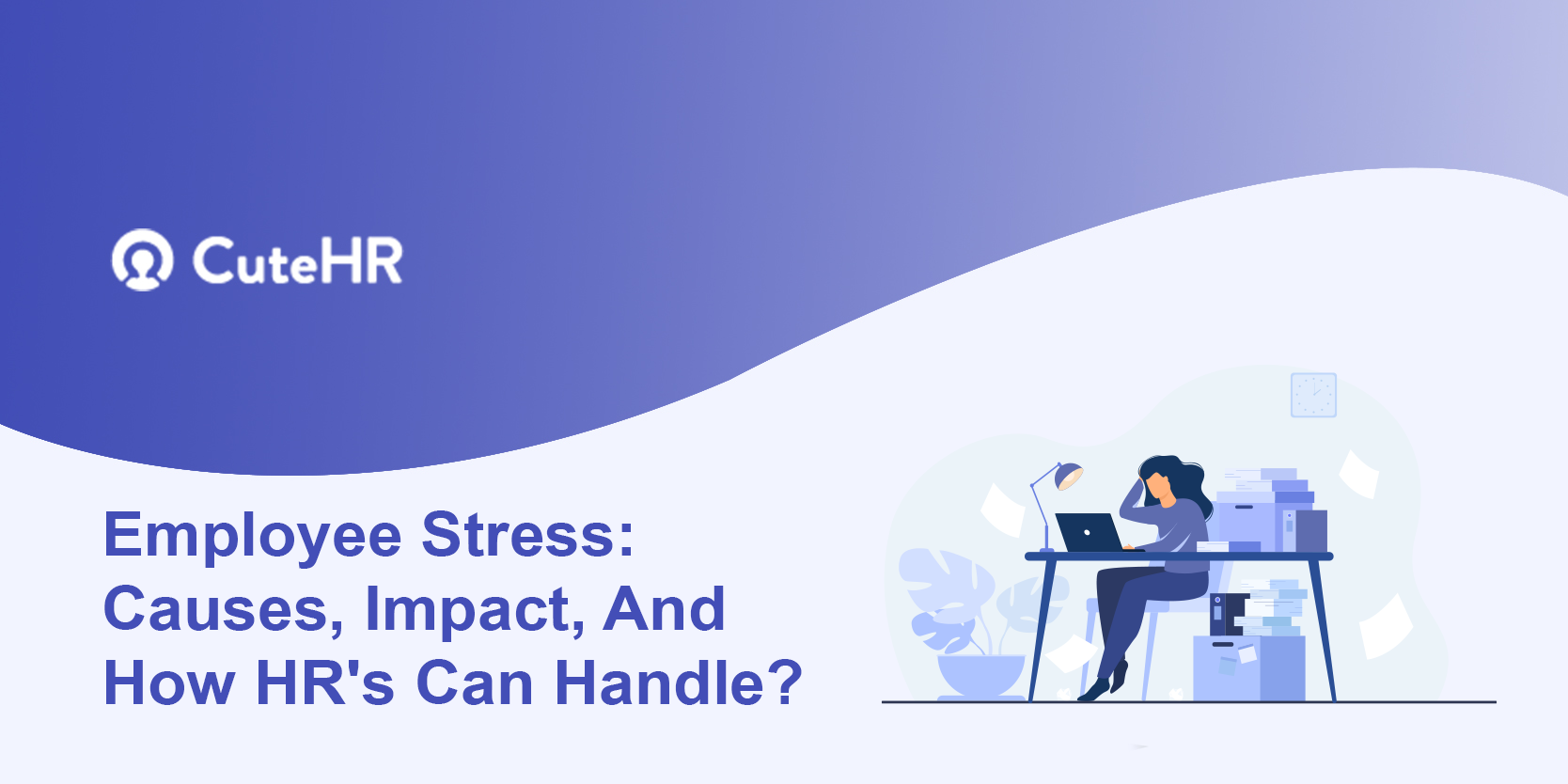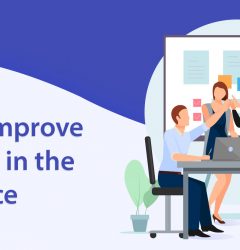28 Jun

Table of Contents
What is Employee Stress?
“Work enhances a person’s health in a variety of ways, as well as their entire outlook on life.” As a result of the employee stress they endure at work, many people’s health is put in jeopardy.
There is a wide range of employee stress levels among occupations and populations. The danger of stress is greater for some workers than for others. Employee stress and associated repercussions are most likely to affect younger workers, women, and those in lower-skilled occupations.
As a result of their lack of job control and high demands, casual full-time workers face the worst job-strain risks of all workers.
Employee stress is becoming a rising concern for businesses today. Stress is defined as a dynamic situation in which people encounter limits, possibilities, or the loss of what they seek, and the outcome is both unpredictable and critical. People experience stress as a reaction to unreasonable/excessive pressure or demands placed on them.
Stress is not always a bad thing. It can also bring out the best in people at times. It may inspire a person to come up with new and smarter ways of doing things. This good aspect of stress is known as eustress.
However, the term employee stress usually has a negative connotation, and this negative element of employee stress is referred to as a source of distress. For example, when a subordinate is harassed or admonished by his superior, dissatisfied with an unsuitable job, and so on. “Stress leads some people to break, and others to break records,” we can remark.
But what one individual perceives as stressful, another may see as a challenge. How much work-related stress a person endures varies with the profession, the person’s psychological make-up, and other variables (such as personal life and general health).
The Impacts of Employee Stress
Physical and psychosocial employee stress are distinguished. Noise, poor lighting, poor office or work arrangement, and ergonomic problems such as poor working postures are examples of physical stressors.
Psychosocial employee stress is undoubtedly the most common stressors. High job demands, inflexible working hours, poor job control, bad work design and structure, bullying, harassment, and job insecurity are examples of these.
Employee stress not only impacts employees but also harms company performance. The effects of job-related stress can be seen in employees’ physical health, emotional health, and behavior.
Physical and psychosocial workplace pressures are distinguished. Noise, poor lighting, poor office or work arrangement, and ergonomic problems such as poor working postures are examples of physical stressors.
Employee stress harms workers’ mental health, increasing their risk of anxiety, burnout, depression, and substance use disorders. Employees that are stressed at work are more prone to participate in risky behaviors such as cigarette smoking, alcohol and drug addiction, and bad food habits.
Causes of Employee Stress
It is critical to recognize the common sources of workplace stress so that you can make efforts to lower stress levels where possible. Employee stress can be induced by a variety of reasons, including hard workloads and over-promotion, as well as bullying and a blaming culture.
The following are some of the most typical occupational stressors:
High Workloads
Excessive labor and unrealistic deadlines cause people to feel rushed, pressed, and stressed.
Insufficient Workloads
This gives people the impression that their abilities are underutilized. It has the potential to make people feel less secure in their jobs.
Lack of skills
People who are requested to do a job for which they do not have the necessary expertise or training.
Work security stress
Concerns about work stability, a lack of professional options, or a low salary.
Lack of control
Having little influence over job activities.
Changing and adapting
Having trouble adjusting to a new position, both in terms of meeting the duties of the new role and adapting to any changes in relationships with colleagues.
No support
An individual may feel alone due to a lack of interpersonal support or a lack of good working relationships.
Ineffective or weak management
Consequently, employees are left with a lack of direction.
Blame culture
In this culture, people are terrified of making mistakes or admitting, they have done so.
Powerless or incapable management
This clears out workers feeling they do not have a sense of course.
Lack of communication
Failure to keep employees informed about big corporate developments, prompting them to be concerned about their future.
Over management
This may take off workers feeling underestimated and influence their self-esteem.
Inadequate physical working conditions
Excessive heat, cold, or noise, for example, inadequate lighting, uncomfortable seats, malfunctioning equipment, and so on.
Numerous detailing lines
Hazy chains of command, with each director inquiring for their work to be prioritized.
Symptoms of Employee Stress
Recognizing signs and symptoms of stress may be more difficult than you think, whether you are an employer or an employee. Here are some important facts about stress:
- Employee Stress can be short-term or long-term.
- Employee stress can be severe or mild — in certain circumstances, long-term mild stress might be more damaging than short-term, high stress.
- Anything can induce stress, even things you wouldn’t expect to!
- Someone can be stressed and not even be aware of it.
- Each person’s response to stress is unique, but there are some similar signs and symptoms.
- Almost everything in our life is interconnected. There are several ways in which stress from a personal problem might spill over into the workplace.
Headaches
Headaches are another typical stress symptom, and thankfully one of the easiest to identify. Headaches are often a red signal because they are quickly evident if you are in pain and are a clear indication that something is wrong.
You may believe you are suffering from a physical sickness – anything from a mild head cold to something far more serious
that necessitates a trip to the doctor – but stress could be the underlying cause of your need for paracetamol.
Insomnia
Even though low energy levels are a common indicator of stress, many people have trouble sleeping. Another symptom that you’re having trouble with is insomnia. Some people will discover that their insomnia is stress-related and will lie awake at night pondering all of the things that are making them anxious, while others will be unable to sleep for no apparent reason.
Low Energy
Low energy is one of the most prevalent indicators of employee stress, yet it may not be observed right away. It may begin with a minor increase in fatigue or difficulty concentrating at work, but more severe stress can result in more noticeable signs and symptoms.
If an employee is consistently late because they have slept through their alarm, you may have an employee with employee stress. This may not be an old excuse, but it could be a legitimate reason: people who are stressed can be so fatigued that they can’t get out of bed in the morning.
Is it a symptom of stress, or are you simply staying up too late if you’re an employee and feel like you need a nap or are falling asleep on the job?
Muscle Tension
Our muscles tend to stiffen up when we’re agitated, whether we’re aware of it or not. You may not be aware that you’re tense, but you’ll be aware when your shoulders ache, or your neck hurts. If you’re suffering from stress, you may be experiencing the same physical symptoms that are produced by incorrect posture.
Frequent Illness
When the immune system is under stress for a long period, it becomes less effective in fighting an illness. The effect of this is that people who suffer from stress are more likely to get sick with colds, coughs, and other diseases.
Employees who continually complain about their health or who have had to take more than the normal number of days off from work could be a sign of this, according to an employer’s point of view.
Another possibility is that the employee hasn’t connected these indications with stress and needs a supervisor to point it out!
Upset Stomach and Nausea
In some circumstances, nausea or an upset stomach might be attributable to stress. It’s not uncommon for the body to be under stress just as the mind – either because the cause of stress is physical or because the emotions activate a fight or flight response, creating an internal imbalance.
Anger and Snappy Behavior
In times of stress, you may feel irritated or angry for no reason at all. In addition to snappy or sarcastic behavior, a stressed employee may sound annoyed or appear too emotional – they may cry when given constructive comments or appear scared.
Is Employee Stress a Big Deal? Does it matter?
Insights appear that 10.4 million working days are misplaced each year to push and other conditions such as discouragement and uneasiness. The long-term impacts of stretch can incorporate chest torments and blood weight issues, as well as an assortment of other side effects and conditions that can have an impressive effect on the sufferer’s wellbeing.
You might think of push as being a mental or passionate condition, but the effect on the body is critical.
How Can an Employer Help Employees Feel Less Stressed?
It’s not possible for managers to just wave their magic wand and make all of the anxiety and panic generated by the virus vanish, but they may help stressed-out employees during this period by employing several tactics in the workplace to help reduce the burden. There are some tips on how can an employer help employees feel less stressed:-
Discuss the topic of stress
Simply acknowledging the presence of workplace stress and initiating a conversation reduces the number of stressed employees and lowers employee attrition rates.
Recognize your employees
Representatives who get acknowledgment feel more closely associated with their company’s reason which, in turn, brings down push. Interests, supervisors who give acknowledgment regularly are too more likely to have a positive working involvement.
Abbreviate the lines
It’s no surprise that those team members who feel that they can reach out to their direct manager or HR staff, or even their senior managers, tend to be more engaged, and This can entail sending a quick message via the company’s internal mobile communication app instead of showing up for dinner with the CEO.
Give a two-way stage
There are few things more upsetting or disappointing than feeling unheard. Whether through customary group stand-ups with supervisors or by coordination an app for inside communications, give colleagues with the implies to input.
Provide support
Support does not entail hugging all of your stressed-out colleagues daily. Make certain, however, that they know exactly where to go to acquire the tools they require, the information they may require to cope with difficult situations, and simple access to the correct contacts if they have questions. Your intranet or internal employee communications platform is the ideal resource because it can be kept up to date and accessed by all employees whenever they need it.
Encourage activity
Employee stress can be reduced by engaging in regular physical Simple. It’s possible to go all out and provide your staff free access to local gyms, or you can simply urge them to take a stroll during their breaks.
Holidays are sacred
When employees take annual leave or vacations, make sure they can step away from their work and leave it behind. This will make them happier and more productive in the long run.
Set up clear boundaries
The more upsetting the work, the more likely your colleagues are to require that stretch domestic with them, which makes a horrendous push circle. Make beyond any doubt representatives can completely detach when not at work.
Work and pleasure should be kept apart
Numerous companies still utilize content messages or Whatsapp to communicate with their cutting-edge specialists. Aside from the legitimate issues with this, it moreover implies that laborers are assaulted with proficient messages and chat on their stages and can’t control the partition of individual and proficient. A devoted, branded portable inside representative communications stage gives partition and clarity.
Teach them something new
The benefits of learning something new are well-documented. Other benefits include stronger team relations when coworkers study together; employees who feel like their firm invests in them are likely to feel more motivated, and the company ends up with a more highly skilled employee! Win-win-win-win.
Create peer networks
Whether physical or computerized, making bunches in which all individuals of staff can examine issues and indeed complain and the vent is appeared to not as it were sound but can lead to more profitable representatives. These bunches make everybody feel bolstered and can indeed lead to crowdsourcing arrangements.
Activate senior management
The more obvious your senior administration is, the more acknowledged, certain, locked in, and lose your workforce feels.
Give a therapeutic break environment
A healthy diet has been demonstrated to reduce stress time and time again. If you want to encourage healthy eating habits in your employees and limit the prevalence of vending machines filled with candy and sugary drinks, make sure they have better access to fruit, salads. Make sure your employees can take their time eating and relax instead of grabbing hasty nibbles behind the cash register while no one is watching, ensuring they are eating healthily.
Individual Strategies For Managing Employee Stress
- Employees should create a daily “to-do” list, prioritize the acts on the list, and plan the activities accordingly. Take regular pauses from work to unwind. Employees that use efficient time management can reach their goals on schedule, meet job challenges, and prevent stress.
- Engage in some physical activity. It promotes healthy blood circulation, keeps you fit, and diverts your attention away from work-related stressors.
- Do difficult work. Endeavor to realize your objectives but don’t do it to the hurt of family, wellbeing, or peer.
- Employees should approach their work with optimism. They should avoid making connections with personnel who have a negative approach.
- Encourage a healthy way of life. Sleep regularly, drink enough water, and maintain good eating habits. Encourage relaxing activities such as yoga, music listening, and meditation.
- Employees should be emotionally intelligent at work. At work, they should be self-aware, self-confident, and self-control.
- Employees should approach their work with optimism. They should avoid making connections with personnel who have a negative approach.
- Employees should develop social support. They should have close relationships with reliable peers who can listen to their issues and build their confidence. This social network will assist employees in dealing with stress.
- Employee counseling is an excellent method for reducing employee stress. Employees can become aware of their strengths and how to enhance those qualities, as well as their flaws and how to eradicate them, through counseling, and they can establish techniques for modifying their behavior. Employees are also provided career counseling, which helps to reduce their professional ambiguity.
- Find a pleasant activity to relieve tension, such as telling jokes, playing tennis, golf, or other sports.
- Don’t get too caught up with yourself. Turn your attention to the outside world. Assist others. This will relieve some of your stress.
Wrapping It Up
Employee stress is described as the detrimental physical and emotional responses that occur when the job requirements do not meet the worker’s capabilities, resources, or demands. Employee stress can lead to ill health and even injury. In a nutshell, the setting is set for illness, injury, and job loss.
Frequently Asked Questions (FAQs)
What are the effects of employee stress?
Stress contributes to decreased organizational performance, decreased overall employee performance, a high error rate and poor quality of work, high staff turnover, and absence owing to health issues such as anxiety, emotional disorder, and work-life imbalance.
Is employee stress a mental illness?
Workplace stress can exacerbate an already existing mental health problem, making it more difficult to manage. When work-related stress gets so severe that it triggers an already existing mental health problem, it becomes difficult to distinguish one from the other.












Himani